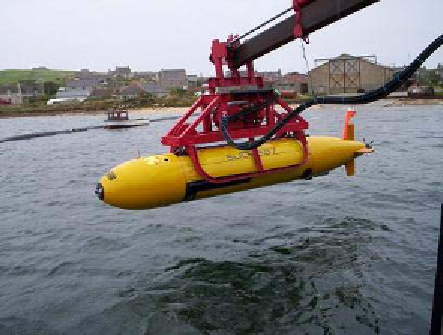Biomedical Engineering Reference
In-Depth Information
Figure 2. Autonomous underwater vehicle with a planning module based on an expert system (EN4AUV)
and classical approaches for guidance, control and navigation systems
addition, missions can be done in a cheaper way
due to less support infrastructure required. These
contrasts become more evident as the mission
depth increases. Hence, within the Framework
Program Fifth, the EU funded AUTOTRACKER
Project was thought to show that the technology
was mature enough to face this autonomous
underwater pipelines and cables inspections.
The main features of the full AUTOTRACKER
architecture, focussing in the dynamic mission
planner to generate the AUV trajectories, are
described in (Acosta, Curti, Calvo, Evans & Lane,
2005-in press).
The navigation system consisted of a geopo-
sitional system (GPS) giving an absolute posi-
tion in global coordinates (latitude, longitude), a
depth sensor, and an inertial navigation system
based on gyroscopes that gives a relative position
when the AUV is submerged. For the inspection
task, data was acquired with a multi-beam echo
sounder (MBE). Raw data from this MBE is
processed by the MBE Tracer module, which can
also generate a predicted target trajectory, using
image-processing techniques (Tena Ruiz, Petillot
& Lane, 2003). Position and direction of the target
under inspection is estimated this tracer, together
with a priori information about the lay down of
the pipeline or cable, called legacy data. They
are combined through a sensor fusion module
(SFM). Using the information from the SFM and
a priori information, the dynamic mission plan-
ning module, decided the path to follow on the
different situations: search, track, reacquire, and
skip from current position. The obstacle avoid-
ance system (OAS) took the trajectories proposed
by the
EN4AUV
expert system and validated or
modify them using the information coming from
the forward looking sonar and the exclusion zones
in legacy data. Then both, the
EN4AUV
and the
OAS are the main components of the DMP.
When doing the underwater inspections,
complex situations might appear (like the sud-
den appearance of a fishing net, a complex pat-
tern of more than one pipeline over the seabed,
or a detour due to obstacle detection, and many
others). These situations were coded as possible
scenarios, in about fifty rules. As the knowledge
about different situations increases, the knowl-
edge base (KB) describing new scenarios may
be simply and naturally completed and updated,
yielding an incremental KB growth. Each scenario
triggers different searching or tracking pattern


Search WWH ::

Custom Search